Strategic Change Management: Sainsbury's Expansion Plan in Nigeria
VerifiedAdded on 2023/06/15
|10
|2617
|472
Report
AI Summary
This report provides a strategic change management plan for Sainsbury's expansion into Nigeria, focusing on strategic audit and change management to establish a strong international foothold. It addresses challenges like weak strategies and the importance of employee training, advocating for challenge-based development. The report applies Kotter's Change Management Model to facilitate organizational change, emphasizing the creation of urgency, building a coalition, and communicating a clear vision. It also considers the socio-cultural dynamics of Nigeria using the HOFSTEDE framework and employs PESTLE and Porter's Five Forces to analyze the country's market environment. The report highlights the need for organizational coordination, understanding cultural nuances, and effective communication, recommending a scalable strategy with ongoing training and transparent communication for successful implementation. Desklib provides access to this and many other solved assignments for students.
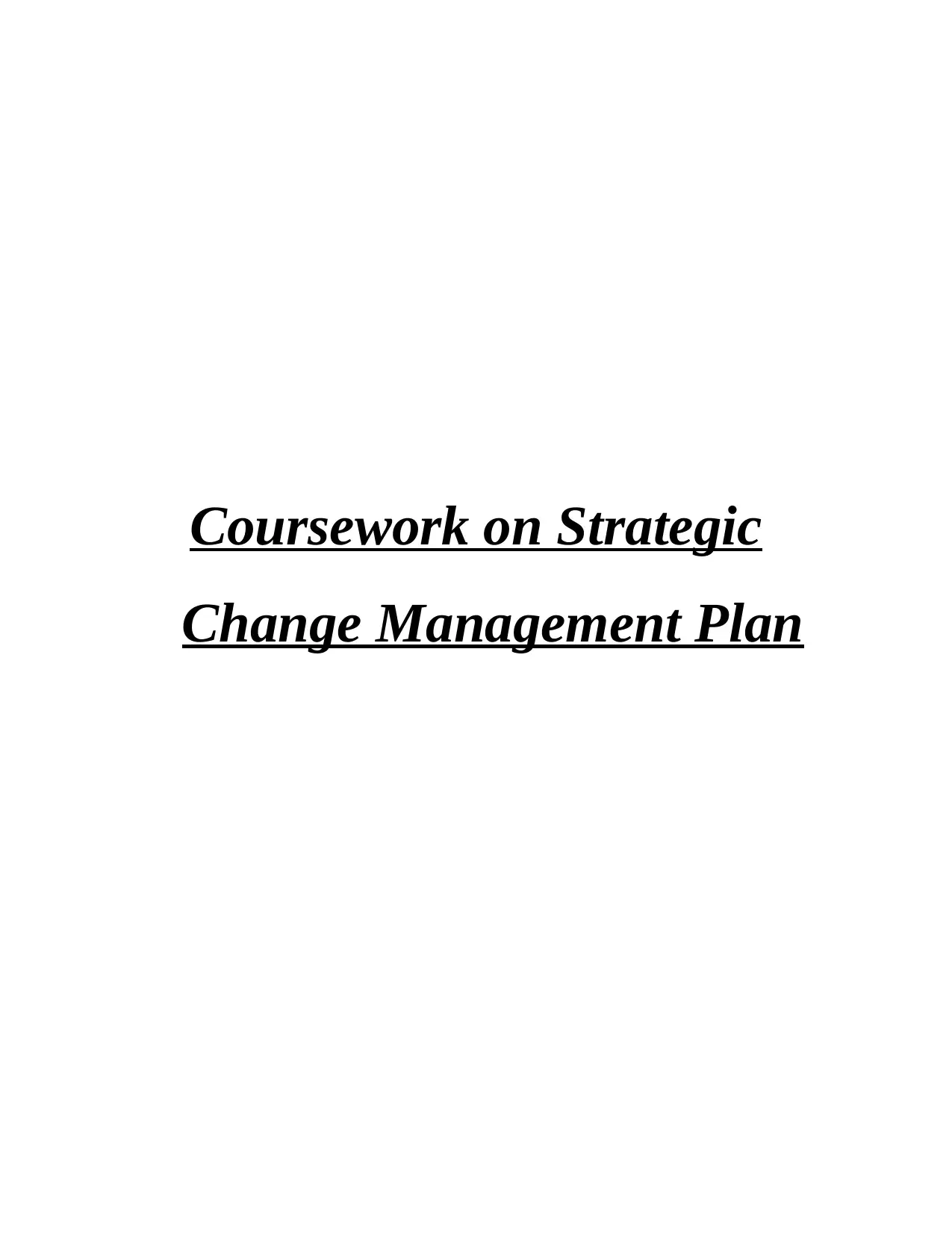
Coursework on Strategic
Change Management Plan
Change Management Plan
Paraphrase This Document
Need a fresh take? Get an instant paraphrase of this document with our AI Paraphraser
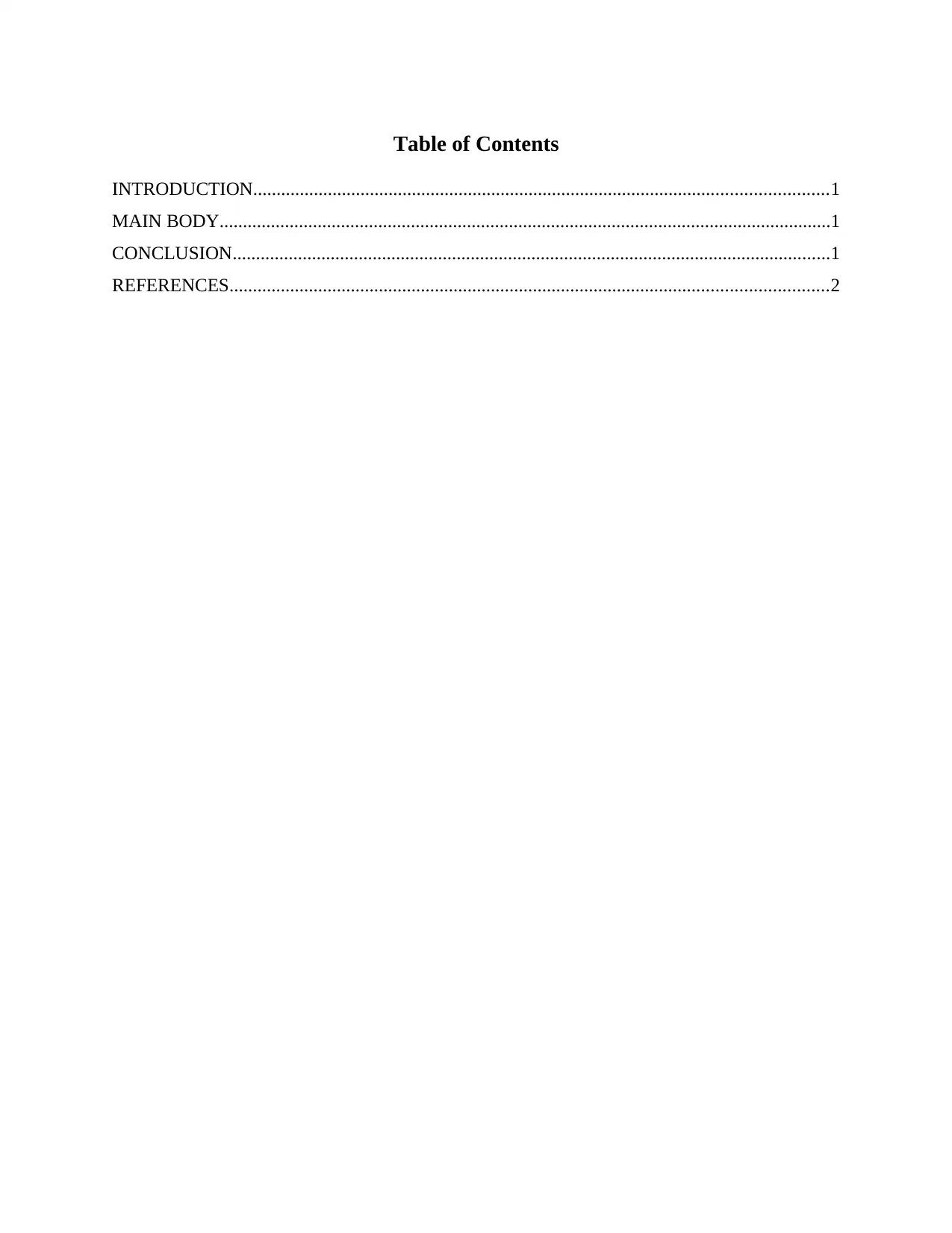
Table of Contents
INTRODUCTION...........................................................................................................................1
MAIN BODY...................................................................................................................................1
CONCLUSION................................................................................................................................1
REFERENCES................................................................................................................................2
INTRODUCTION...........................................................................................................................1
MAIN BODY...................................................................................................................................1
CONCLUSION................................................................................................................................1
REFERENCES................................................................................................................................2
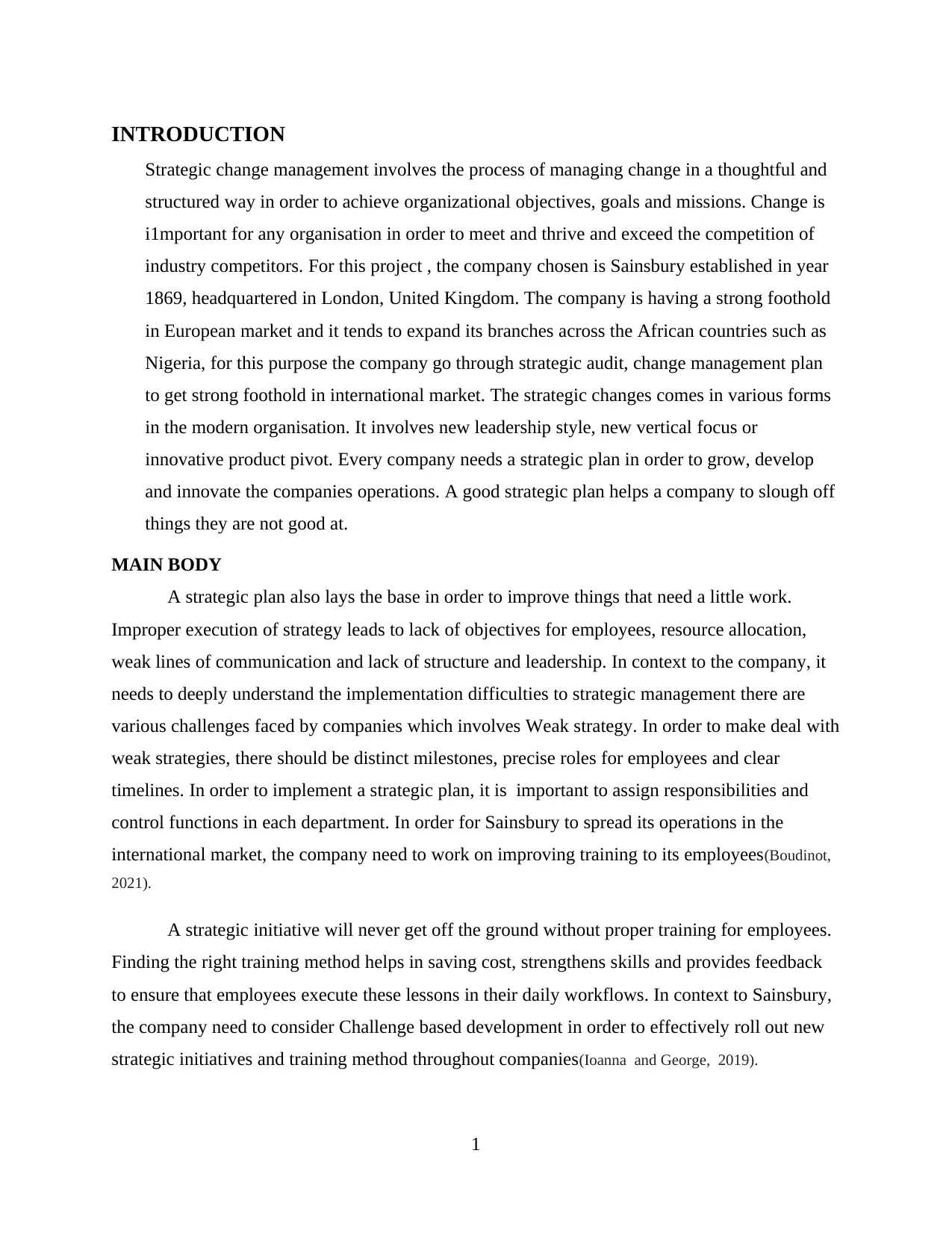
INTRODUCTION
Strategic change management involves the process of managing change in a thoughtful and
structured way in order to achieve organizational objectives, goals and missions. Change is
i1mportant for any organisation in order to meet and thrive and exceed the competition of
industry competitors. For this project , the company chosen is Sainsbury established in year
1869, headquartered in London, United Kingdom. The company is having a strong foothold
in European market and it tends to expand its branches across the African countries such as
Nigeria, for this purpose the company go through strategic audit, change management plan
to get strong foothold in international market. The strategic changes comes in various forms
in the modern organisation. It involves new leadership style, new vertical focus or
innovative product pivot. Every company needs a strategic plan in order to grow, develop
and innovate the companies operations. A good strategic plan helps a company to slough off
things they are not good at.
MAIN BODY
A strategic plan also lays the base in order to improve things that need a little work.
Improper execution of strategy leads to lack of objectives for employees, resource allocation,
weak lines of communication and lack of structure and leadership. In context to the company, it
needs to deeply understand the implementation difficulties to strategic management there are
various challenges faced by companies which involves Weak strategy. In order to make deal with
weak strategies, there should be distinct milestones, precise roles for employees and clear
timelines. In order to implement a strategic plan, it is important to assign responsibilities and
control functions in each department. In order for Sainsbury to spread its operations in the
international market, the company need to work on improving training to its employees(Boudinot,
2021).
A strategic initiative will never get off the ground without proper training for employees.
Finding the right training method helps in saving cost, strengthens skills and provides feedback
to ensure that employees execute these lessons in their daily workflows. In context to Sainsbury,
the company need to consider Challenge based development in order to effectively roll out new
strategic initiatives and training method throughout companies(Ioanna and George, 2019).
1
Strategic change management involves the process of managing change in a thoughtful and
structured way in order to achieve organizational objectives, goals and missions. Change is
i1mportant for any organisation in order to meet and thrive and exceed the competition of
industry competitors. For this project , the company chosen is Sainsbury established in year
1869, headquartered in London, United Kingdom. The company is having a strong foothold
in European market and it tends to expand its branches across the African countries such as
Nigeria, for this purpose the company go through strategic audit, change management plan
to get strong foothold in international market. The strategic changes comes in various forms
in the modern organisation. It involves new leadership style, new vertical focus or
innovative product pivot. Every company needs a strategic plan in order to grow, develop
and innovate the companies operations. A good strategic plan helps a company to slough off
things they are not good at.
MAIN BODY
A strategic plan also lays the base in order to improve things that need a little work.
Improper execution of strategy leads to lack of objectives for employees, resource allocation,
weak lines of communication and lack of structure and leadership. In context to the company, it
needs to deeply understand the implementation difficulties to strategic management there are
various challenges faced by companies which involves Weak strategy. In order to make deal with
weak strategies, there should be distinct milestones, precise roles for employees and clear
timelines. In order to implement a strategic plan, it is important to assign responsibilities and
control functions in each department. In order for Sainsbury to spread its operations in the
international market, the company need to work on improving training to its employees(Boudinot,
2021).
A strategic initiative will never get off the ground without proper training for employees.
Finding the right training method helps in saving cost, strengthens skills and provides feedback
to ensure that employees execute these lessons in their daily workflows. In context to Sainsbury,
the company need to consider Challenge based development in order to effectively roll out new
strategic initiatives and training method throughout companies(Ioanna and George, 2019).
1
⊘ This is a preview!⊘
Do you want full access?
Subscribe today to unlock all pages.

Trusted by 1+ million students worldwide
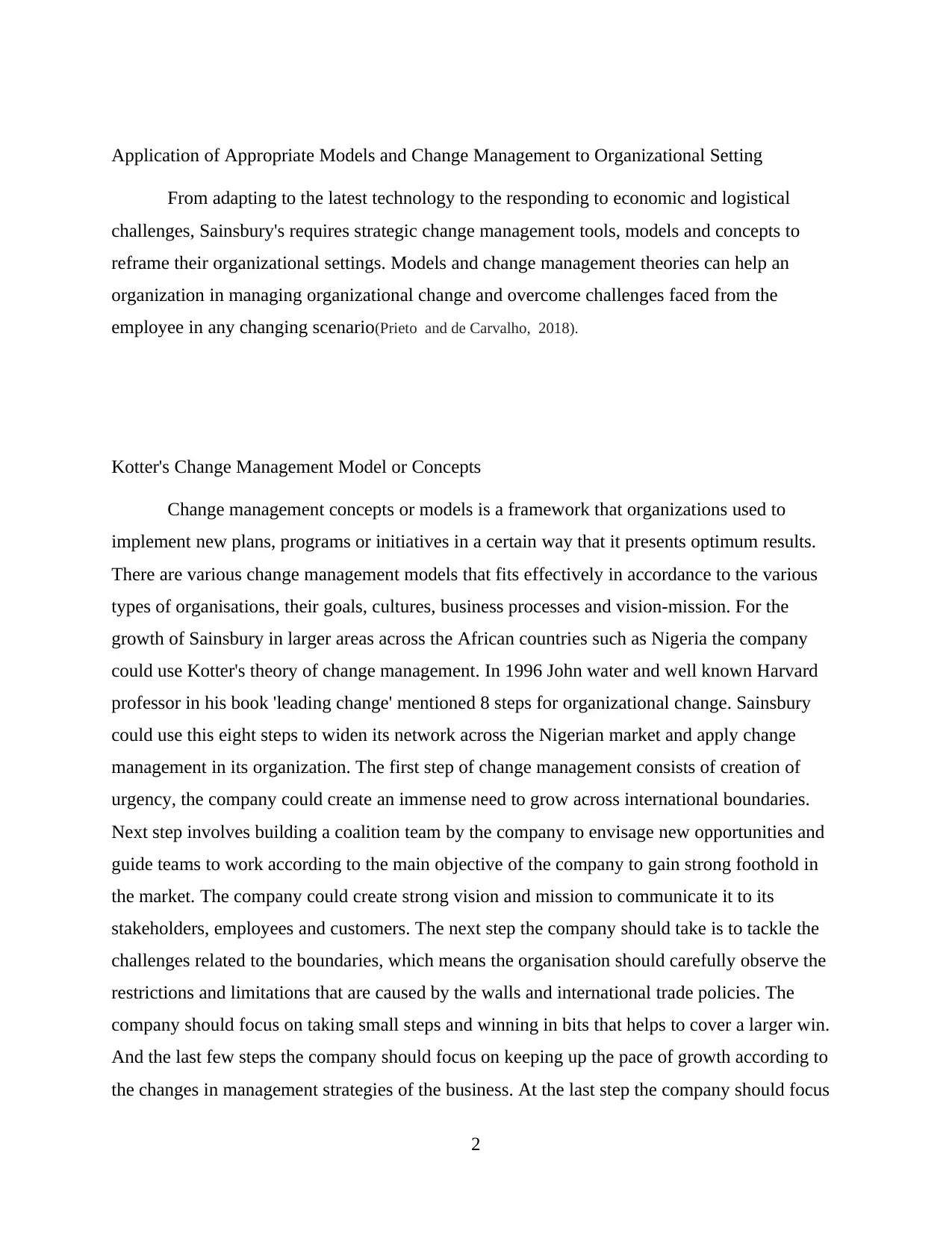
Application of Appropriate Models and Change Management to Organizational Setting
From adapting to the latest technology to the responding to economic and logistical
challenges, Sainsbury's requires strategic change management tools, models and concepts to
reframe their organizational settings. Models and change management theories can help an
organization in managing organizational change and overcome challenges faced from the
employee in any changing scenario(Prieto and de Carvalho, 2018).
Kotter's Change Management Model or Concepts
Change management concepts or models is a framework that organizations used to
implement new plans, programs or initiatives in a certain way that it presents optimum results.
There are various change management models that fits effectively in accordance to the various
types of organisations, their goals, cultures, business processes and vision-mission. For the
growth of Sainsbury in larger areas across the African countries such as Nigeria the company
could use Kotter's theory of change management. In 1996 John water and well known Harvard
professor in his book 'leading change' mentioned 8 steps for organizational change. Sainsbury
could use this eight steps to widen its network across the Nigerian market and apply change
management in its organization. The first step of change management consists of creation of
urgency, the company could create an immense need to grow across international boundaries.
Next step involves building a coalition team by the company to envisage new opportunities and
guide teams to work according to the main objective of the company to gain strong foothold in
the market. The company could create strong vision and mission to communicate it to its
stakeholders, employees and customers. The next step the company should take is to tackle the
challenges related to the boundaries, which means the organisation should carefully observe the
restrictions and limitations that are caused by the walls and international trade policies. The
company should focus on taking small steps and winning in bits that helps to cover a larger win.
And the last few steps the company should focus on keeping up the pace of growth according to
the changes in management strategies of the business. At the last step the company should focus
2
From adapting to the latest technology to the responding to economic and logistical
challenges, Sainsbury's requires strategic change management tools, models and concepts to
reframe their organizational settings. Models and change management theories can help an
organization in managing organizational change and overcome challenges faced from the
employee in any changing scenario(Prieto and de Carvalho, 2018).
Kotter's Change Management Model or Concepts
Change management concepts or models is a framework that organizations used to
implement new plans, programs or initiatives in a certain way that it presents optimum results.
There are various change management models that fits effectively in accordance to the various
types of organisations, their goals, cultures, business processes and vision-mission. For the
growth of Sainsbury in larger areas across the African countries such as Nigeria the company
could use Kotter's theory of change management. In 1996 John water and well known Harvard
professor in his book 'leading change' mentioned 8 steps for organizational change. Sainsbury
could use this eight steps to widen its network across the Nigerian market and apply change
management in its organization. The first step of change management consists of creation of
urgency, the company could create an immense need to grow across international boundaries.
Next step involves building a coalition team by the company to envisage new opportunities and
guide teams to work according to the main objective of the company to gain strong foothold in
the market. The company could create strong vision and mission to communicate it to its
stakeholders, employees and customers. The next step the company should take is to tackle the
challenges related to the boundaries, which means the organisation should carefully observe the
restrictions and limitations that are caused by the walls and international trade policies. The
company should focus on taking small steps and winning in bits that helps to cover a larger win.
And the last few steps the company should focus on keeping up the pace of growth according to
the changes in management strategies of the business. At the last step the company should focus
2
Paraphrase This Document
Need a fresh take? Get an instant paraphrase of this document with our AI Paraphraser
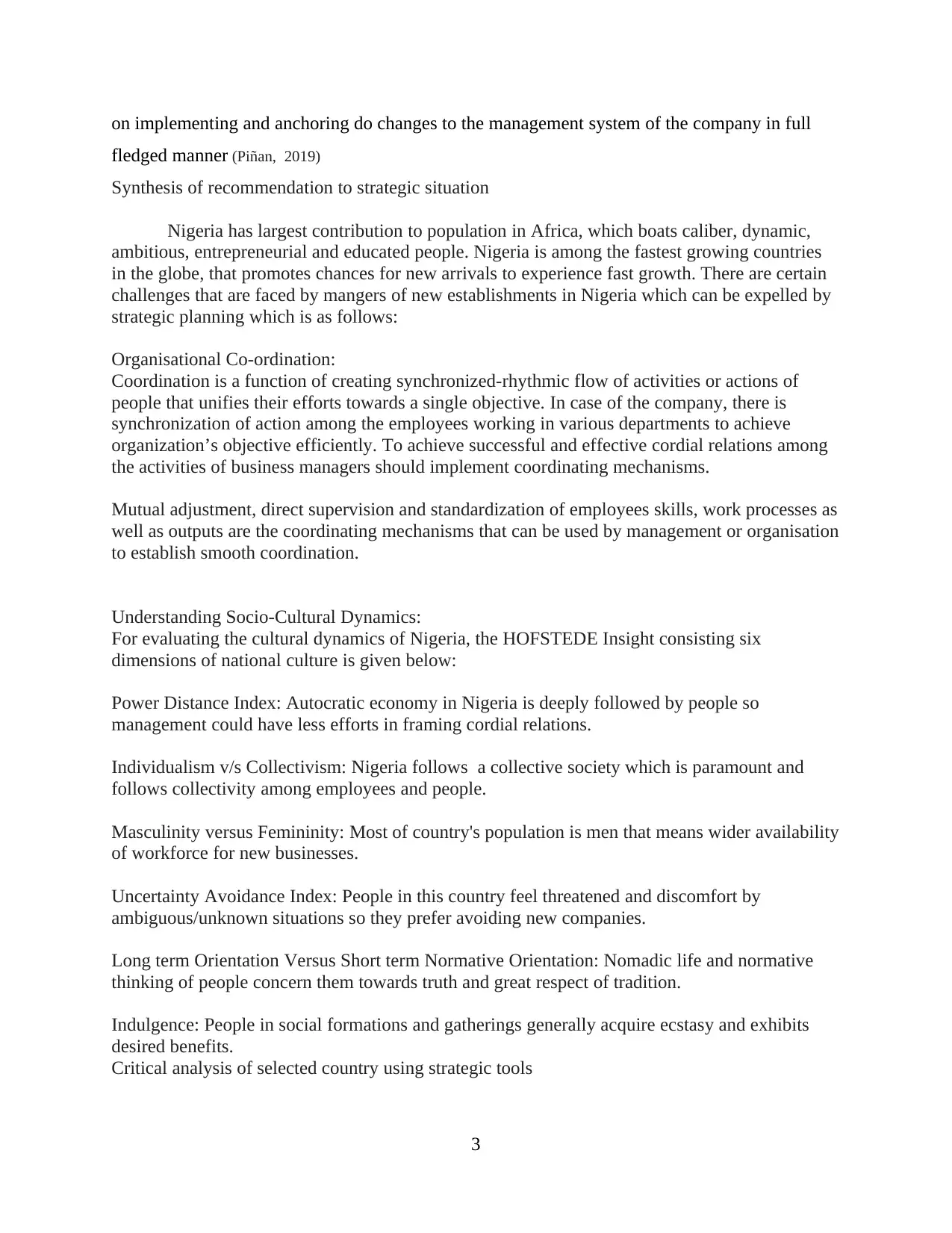
on implementing and anchoring do changes to the management system of the company in full
fledged manner (Piñan, 2019)
Synthesis of recommendation to strategic situation
Nigeria has largest contribution to population in Africa, which boats caliber, dynamic,
ambitious, entrepreneurial and educated people. Nigeria is among the fastest growing countries
in the globe, that promotes chances for new arrivals to experience fast growth. There are certain
challenges that are faced by mangers of new establishments in Nigeria which can be expelled by
strategic planning which is as follows:
Organisational Co-ordination:
Coordination is a function of creating synchronized-rhythmic flow of activities or actions of
people that unifies their efforts towards a single objective. In case of the company, there is
synchronization of action among the employees working in various departments to achieve
organization’s objective efficiently. To achieve successful and effective cordial relations among
the activities of business managers should implement coordinating mechanisms.
Mutual adjustment, direct supervision and standardization of employees skills, work processes as
well as outputs are the coordinating mechanisms that can be used by management or organisation
to establish smooth coordination.
Understanding Socio-Cultural Dynamics:
For evaluating the cultural dynamics of Nigeria, the HOFSTEDE Insight consisting six
dimensions of national culture is given below:
Power Distance Index: Autocratic economy in Nigeria is deeply followed by people so
management could have less efforts in framing cordial relations.
Individualism v/s Collectivism: Nigeria follows a collective society which is paramount and
follows collectivity among employees and people.
Masculinity versus Femininity: Most of country's population is men that means wider availability
of workforce for new businesses.
Uncertainty Avoidance Index: People in this country feel threatened and discomfort by
ambiguous/unknown situations so they prefer avoiding new companies.
Long term Orientation Versus Short term Normative Orientation: Nomadic life and normative
thinking of people concern them towards truth and great respect of tradition.
Indulgence: People in social formations and gatherings generally acquire ecstasy and exhibits
desired benefits.
Critical analysis of selected country using strategic tools
3
fledged manner (Piñan, 2019)
Synthesis of recommendation to strategic situation
Nigeria has largest contribution to population in Africa, which boats caliber, dynamic,
ambitious, entrepreneurial and educated people. Nigeria is among the fastest growing countries
in the globe, that promotes chances for new arrivals to experience fast growth. There are certain
challenges that are faced by mangers of new establishments in Nigeria which can be expelled by
strategic planning which is as follows:
Organisational Co-ordination:
Coordination is a function of creating synchronized-rhythmic flow of activities or actions of
people that unifies their efforts towards a single objective. In case of the company, there is
synchronization of action among the employees working in various departments to achieve
organization’s objective efficiently. To achieve successful and effective cordial relations among
the activities of business managers should implement coordinating mechanisms.
Mutual adjustment, direct supervision and standardization of employees skills, work processes as
well as outputs are the coordinating mechanisms that can be used by management or organisation
to establish smooth coordination.
Understanding Socio-Cultural Dynamics:
For evaluating the cultural dynamics of Nigeria, the HOFSTEDE Insight consisting six
dimensions of national culture is given below:
Power Distance Index: Autocratic economy in Nigeria is deeply followed by people so
management could have less efforts in framing cordial relations.
Individualism v/s Collectivism: Nigeria follows a collective society which is paramount and
follows collectivity among employees and people.
Masculinity versus Femininity: Most of country's population is men that means wider availability
of workforce for new businesses.
Uncertainty Avoidance Index: People in this country feel threatened and discomfort by
ambiguous/unknown situations so they prefer avoiding new companies.
Long term Orientation Versus Short term Normative Orientation: Nomadic life and normative
thinking of people concern them towards truth and great respect of tradition.
Indulgence: People in social formations and gatherings generally acquire ecstasy and exhibits
desired benefits.
Critical analysis of selected country using strategic tools
3
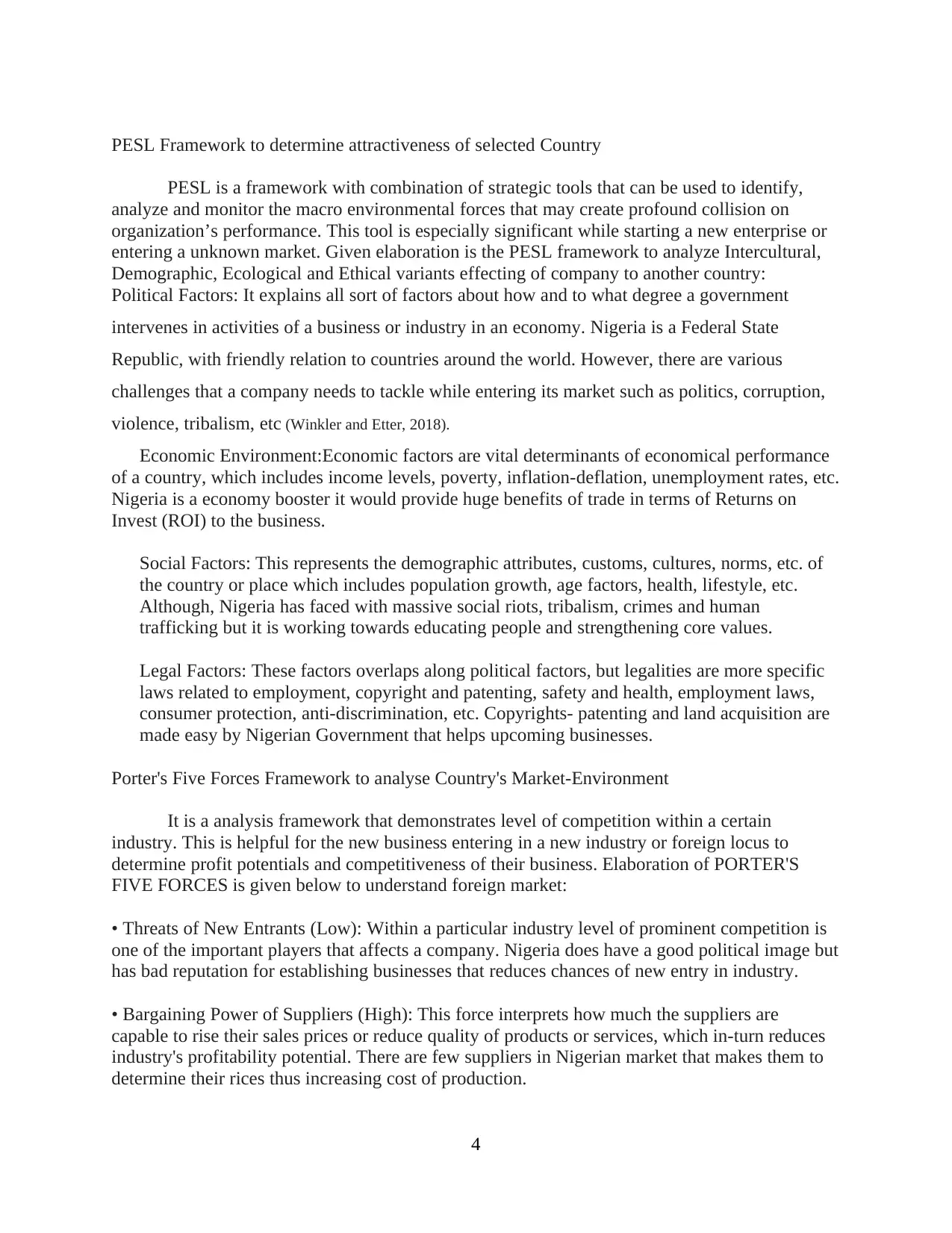
PESL Framework to determine attractiveness of selected Country
PESL is a framework with combination of strategic tools that can be used to identify,
analyze and monitor the macro environmental forces that may create profound collision on
organization’s performance. This tool is especially significant while starting a new enterprise or
entering a unknown market. Given elaboration is the PESL framework to analyze Intercultural,
Demographic, Ecological and Ethical variants effecting of company to another country:
Political Factors: It explains all sort of factors about how and to what degree a government
intervenes in activities of a business or industry in an economy. Nigeria is a Federal State
Republic, with friendly relation to countries around the world. However, there are various
challenges that a company needs to tackle while entering its market such as politics, corruption,
violence, tribalism, etc (Winkler and Etter, 2018).
Economic Environment:Economic factors are vital determinants of economical performance
of a country, which includes income levels, poverty, inflation-deflation, unemployment rates, etc.
Nigeria is a economy booster it would provide huge benefits of trade in terms of Returns on
Invest (ROI) to the business.
Social Factors: This represents the demographic attributes, customs, cultures, norms, etc. of
the country or place which includes population growth, age factors, health, lifestyle, etc.
Although, Nigeria has faced with massive social riots, tribalism, crimes and human
trafficking but it is working towards educating people and strengthening core values.
Legal Factors: These factors overlaps along political factors, but legalities are more specific
laws related to employment, copyright and patenting, safety and health, employment laws,
consumer protection, anti-discrimination, etc. Copyrights- patenting and land acquisition are
made easy by Nigerian Government that helps upcoming businesses.
Porter's Five Forces Framework to analyse Country's Market-Environment
It is a analysis framework that demonstrates level of competition within a certain
industry. This is helpful for the new business entering in a new industry or foreign locus to
determine profit potentials and competitiveness of their business. Elaboration of PORTER'S
FIVE FORCES is given below to understand foreign market:
• Threats of New Entrants (Low): Within a particular industry level of prominent competition is
one of the important players that affects a company. Nigeria does have a good political image but
has bad reputation for establishing businesses that reduces chances of new entry in industry.
• Bargaining Power of Suppliers (High): This force interprets how much the suppliers are
capable to rise their sales prices or reduce quality of products or services, which in-turn reduces
industry's profitability potential. There are few suppliers in Nigerian market that makes them to
determine their rices thus increasing cost of production.
4
PESL is a framework with combination of strategic tools that can be used to identify,
analyze and monitor the macro environmental forces that may create profound collision on
organization’s performance. This tool is especially significant while starting a new enterprise or
entering a unknown market. Given elaboration is the PESL framework to analyze Intercultural,
Demographic, Ecological and Ethical variants effecting of company to another country:
Political Factors: It explains all sort of factors about how and to what degree a government
intervenes in activities of a business or industry in an economy. Nigeria is a Federal State
Republic, with friendly relation to countries around the world. However, there are various
challenges that a company needs to tackle while entering its market such as politics, corruption,
violence, tribalism, etc (Winkler and Etter, 2018).
Economic Environment:Economic factors are vital determinants of economical performance
of a country, which includes income levels, poverty, inflation-deflation, unemployment rates, etc.
Nigeria is a economy booster it would provide huge benefits of trade in terms of Returns on
Invest (ROI) to the business.
Social Factors: This represents the demographic attributes, customs, cultures, norms, etc. of
the country or place which includes population growth, age factors, health, lifestyle, etc.
Although, Nigeria has faced with massive social riots, tribalism, crimes and human
trafficking but it is working towards educating people and strengthening core values.
Legal Factors: These factors overlaps along political factors, but legalities are more specific
laws related to employment, copyright and patenting, safety and health, employment laws,
consumer protection, anti-discrimination, etc. Copyrights- patenting and land acquisition are
made easy by Nigerian Government that helps upcoming businesses.
Porter's Five Forces Framework to analyse Country's Market-Environment
It is a analysis framework that demonstrates level of competition within a certain
industry. This is helpful for the new business entering in a new industry or foreign locus to
determine profit potentials and competitiveness of their business. Elaboration of PORTER'S
FIVE FORCES is given below to understand foreign market:
• Threats of New Entrants (Low): Within a particular industry level of prominent competition is
one of the important players that affects a company. Nigeria does have a good political image but
has bad reputation for establishing businesses that reduces chances of new entry in industry.
• Bargaining Power of Suppliers (High): This force interprets how much the suppliers are
capable to rise their sales prices or reduce quality of products or services, which in-turn reduces
industry's profitability potential. There are few suppliers in Nigerian market that makes them to
determine their rices thus increasing cost of production.
4
⊘ This is a preview!⊘
Do you want full access?
Subscribe today to unlock all pages.

Trusted by 1+ million students worldwide
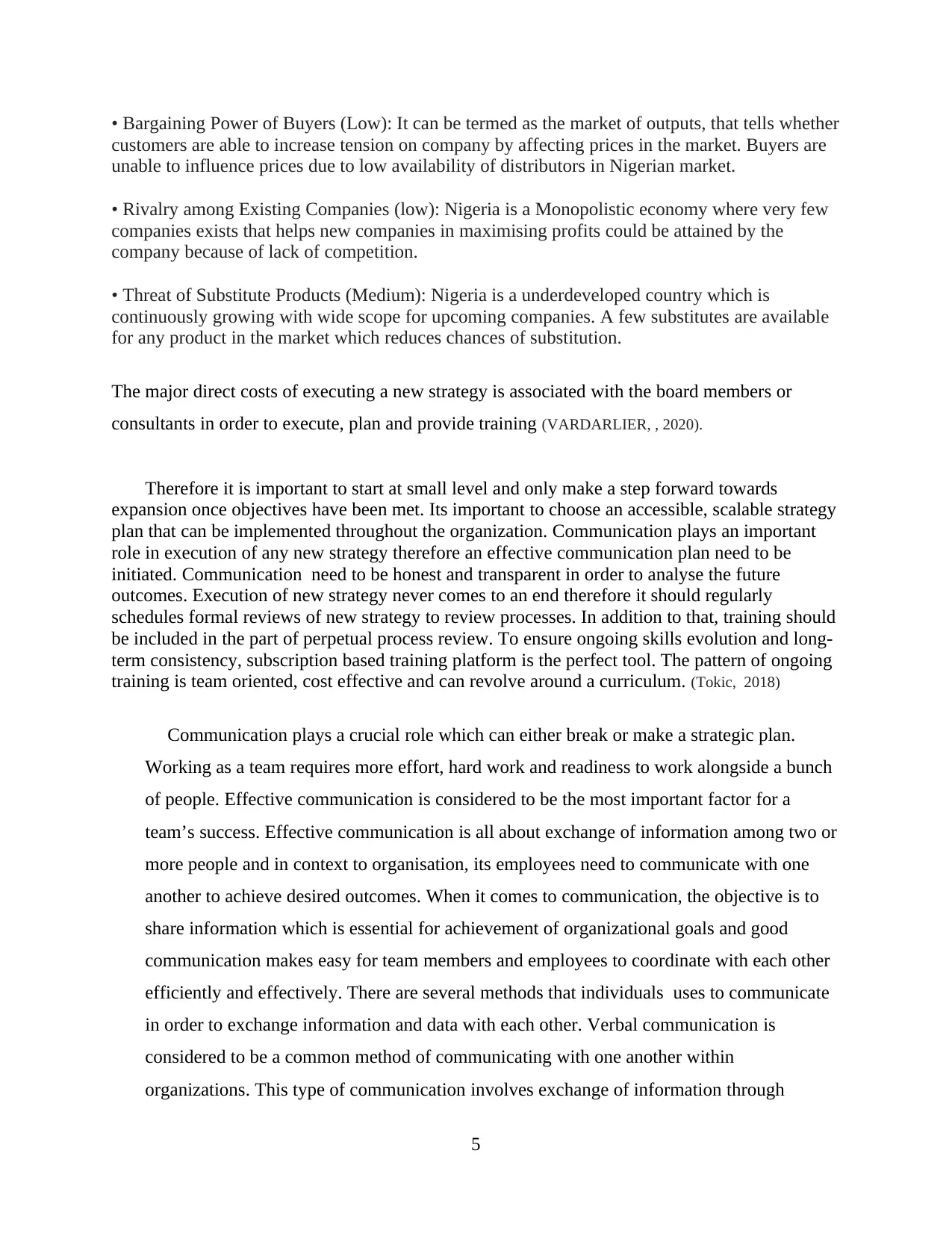
• Bargaining Power of Buyers (Low): It can be termed as the market of outputs, that tells whether
customers are able to increase tension on company by affecting prices in the market. Buyers are
unable to influence prices due to low availability of distributors in Nigerian market.
• Rivalry among Existing Companies (low): Nigeria is a Monopolistic economy where very few
companies exists that helps new companies in maximising profits could be attained by the
company because of lack of competition.
• Threat of Substitute Products (Medium): Nigeria is a underdeveloped country which is
continuously growing with wide scope for upcoming companies. A few substitutes are available
for any product in the market which reduces chances of substitution.
The major direct costs of executing a new strategy is associated with the board members or
consultants in order to execute, plan and provide training (VARDARLIER, , 2020).
Therefore it is important to start at small level and only make a step forward towards
expansion once objectives have been met. Its important to choose an accessible, scalable strategy
plan that can be implemented throughout the organization. Communication plays an important
role in execution of any new strategy therefore an effective communication plan need to be
initiated. Communication need to be honest and transparent in order to analyse the future
outcomes. Execution of new strategy never comes to an end therefore it should regularly
schedules formal reviews of new strategy to review processes. In addition to that, training should
be included in the part of perpetual process review. To ensure ongoing skills evolution and long-
term consistency, subscription based training platform is the perfect tool. The pattern of ongoing
training is team oriented, cost effective and can revolve around a curriculum. (Tokic, 2018)
Communication plays a crucial role which can either break or make a strategic plan.
Working as a team requires more effort, hard work and readiness to work alongside a bunch
of people. Effective communication is considered to be the most important factor for a
team’s success. Effective communication is all about exchange of information among two or
more people and in context to organisation, its employees need to communicate with one
another to achieve desired outcomes. When it comes to communication, the objective is to
share information which is essential for achievement of organizational goals and good
communication makes easy for team members and employees to coordinate with each other
efficiently and effectively. There are several methods that individuals uses to communicate
in order to exchange information and data with each other. Verbal communication is
considered to be a common method of communicating with one another within
organizations. This type of communication involves exchange of information through
5
customers are able to increase tension on company by affecting prices in the market. Buyers are
unable to influence prices due to low availability of distributors in Nigerian market.
• Rivalry among Existing Companies (low): Nigeria is a Monopolistic economy where very few
companies exists that helps new companies in maximising profits could be attained by the
company because of lack of competition.
• Threat of Substitute Products (Medium): Nigeria is a underdeveloped country which is
continuously growing with wide scope for upcoming companies. A few substitutes are available
for any product in the market which reduces chances of substitution.
The major direct costs of executing a new strategy is associated with the board members or
consultants in order to execute, plan and provide training (VARDARLIER, , 2020).
Therefore it is important to start at small level and only make a step forward towards
expansion once objectives have been met. Its important to choose an accessible, scalable strategy
plan that can be implemented throughout the organization. Communication plays an important
role in execution of any new strategy therefore an effective communication plan need to be
initiated. Communication need to be honest and transparent in order to analyse the future
outcomes. Execution of new strategy never comes to an end therefore it should regularly
schedules formal reviews of new strategy to review processes. In addition to that, training should
be included in the part of perpetual process review. To ensure ongoing skills evolution and long-
term consistency, subscription based training platform is the perfect tool. The pattern of ongoing
training is team oriented, cost effective and can revolve around a curriculum. (Tokic, 2018)
Communication plays a crucial role which can either break or make a strategic plan.
Working as a team requires more effort, hard work and readiness to work alongside a bunch
of people. Effective communication is considered to be the most important factor for a
team’s success. Effective communication is all about exchange of information among two or
more people and in context to organisation, its employees need to communicate with one
another to achieve desired outcomes. When it comes to communication, the objective is to
share information which is essential for achievement of organizational goals and good
communication makes easy for team members and employees to coordinate with each other
efficiently and effectively. There are several methods that individuals uses to communicate
in order to exchange information and data with each other. Verbal communication is
considered to be a common method of communicating with one another within
organizations. This type of communication involves exchange of information through
5
Paraphrase This Document
Need a fresh take? Get an instant paraphrase of this document with our AI Paraphraser
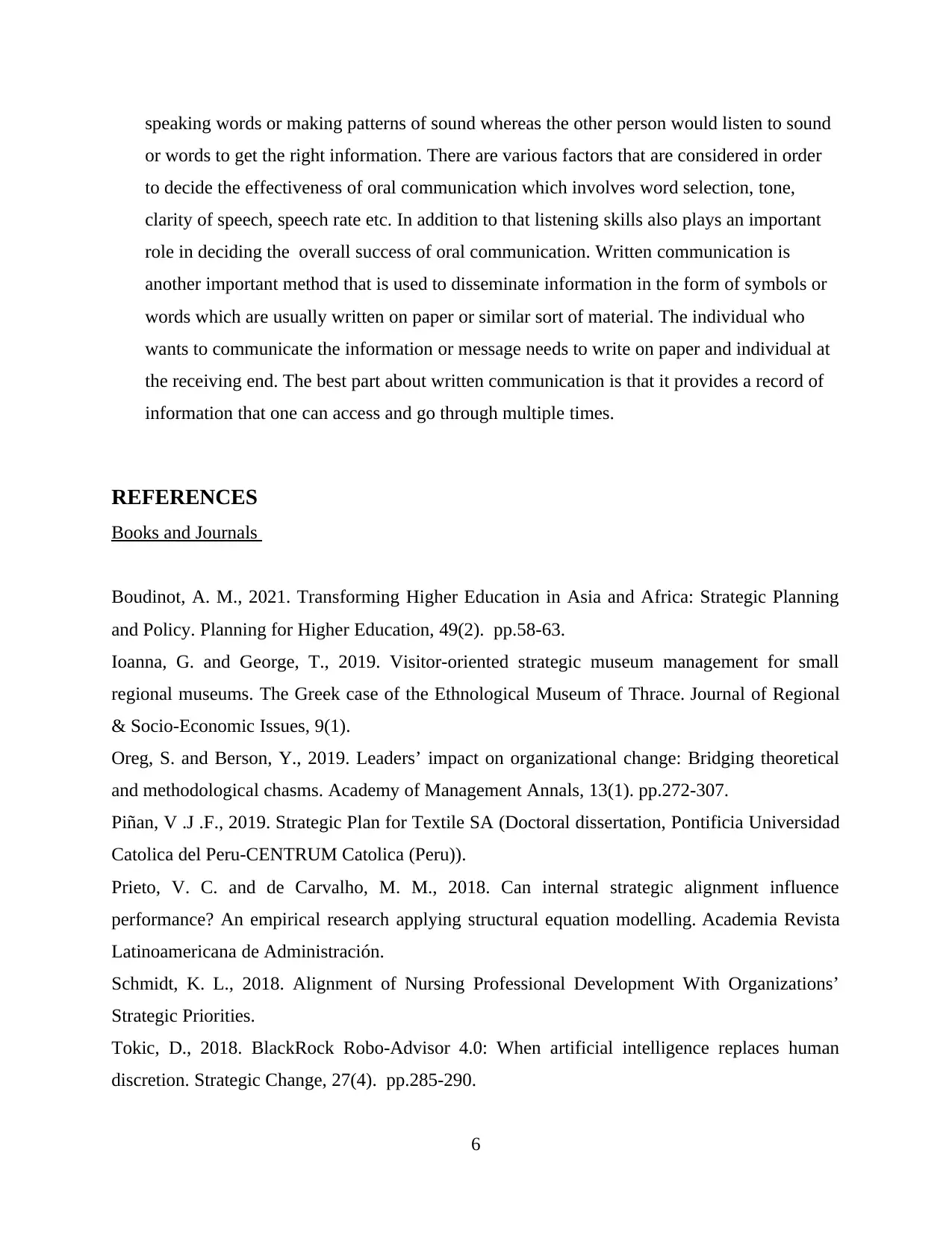
speaking words or making patterns of sound whereas the other person would listen to sound
or words to get the right information. There are various factors that are considered in order
to decide the effectiveness of oral communication which involves word selection, tone,
clarity of speech, speech rate etc. In addition to that listening skills also plays an important
role in deciding the overall success of oral communication. Written communication is
another important method that is used to disseminate information in the form of symbols or
words which are usually written on paper or similar sort of material. The individual who
wants to communicate the information or message needs to write on paper and individual at
the receiving end. The best part about written communication is that it provides a record of
information that one can access and go through multiple times.
REFERENCES
Books and Journals
Boudinot, A. M., 2021. Transforming Higher Education in Asia and Africa: Strategic Planning
and Policy. Planning for Higher Education, 49(2). pp.58-63.
Ioanna, G. and George, T., 2019. Visitor-oriented strategic museum management for small
regional museums. The Greek case of the Ethnological Museum of Thrace. Journal of Regional
& Socio-Economic Issues, 9(1).
Oreg, S. and Berson, Y., 2019. Leaders’ impact on organizational change: Bridging theoretical
and methodological chasms. Academy of Management Annals, 13(1). pp.272-307.
Piñan, V .J .F., 2019. Strategic Plan for Textile SA (Doctoral dissertation, Pontificia Universidad
Catolica del Peru-CENTRUM Catolica (Peru)).
Prieto, V. C. and de Carvalho, M. M., 2018. Can internal strategic alignment influence
performance? An empirical research applying structural equation modelling. Academia Revista
Latinoamericana de Administración.
Schmidt, K. L., 2018. Alignment of Nursing Professional Development With Organizations’
Strategic Priorities.
Tokic, D., 2018. BlackRock Robo‐Advisor 4.0: When artificial intelligence replaces human
discretion. Strategic Change, 27(4). pp.285-290.
6
or words to get the right information. There are various factors that are considered in order
to decide the effectiveness of oral communication which involves word selection, tone,
clarity of speech, speech rate etc. In addition to that listening skills also plays an important
role in deciding the overall success of oral communication. Written communication is
another important method that is used to disseminate information in the form of symbols or
words which are usually written on paper or similar sort of material. The individual who
wants to communicate the information or message needs to write on paper and individual at
the receiving end. The best part about written communication is that it provides a record of
information that one can access and go through multiple times.
REFERENCES
Books and Journals
Boudinot, A. M., 2021. Transforming Higher Education in Asia and Africa: Strategic Planning
and Policy. Planning for Higher Education, 49(2). pp.58-63.
Ioanna, G. and George, T., 2019. Visitor-oriented strategic museum management for small
regional museums. The Greek case of the Ethnological Museum of Thrace. Journal of Regional
& Socio-Economic Issues, 9(1).
Oreg, S. and Berson, Y., 2019. Leaders’ impact on organizational change: Bridging theoretical
and methodological chasms. Academy of Management Annals, 13(1). pp.272-307.
Piñan, V .J .F., 2019. Strategic Plan for Textile SA (Doctoral dissertation, Pontificia Universidad
Catolica del Peru-CENTRUM Catolica (Peru)).
Prieto, V. C. and de Carvalho, M. M., 2018. Can internal strategic alignment influence
performance? An empirical research applying structural equation modelling. Academia Revista
Latinoamericana de Administración.
Schmidt, K. L., 2018. Alignment of Nursing Professional Development With Organizations’
Strategic Priorities.
Tokic, D., 2018. BlackRock Robo‐Advisor 4.0: When artificial intelligence replaces human
discretion. Strategic Change, 27(4). pp.285-290.
6
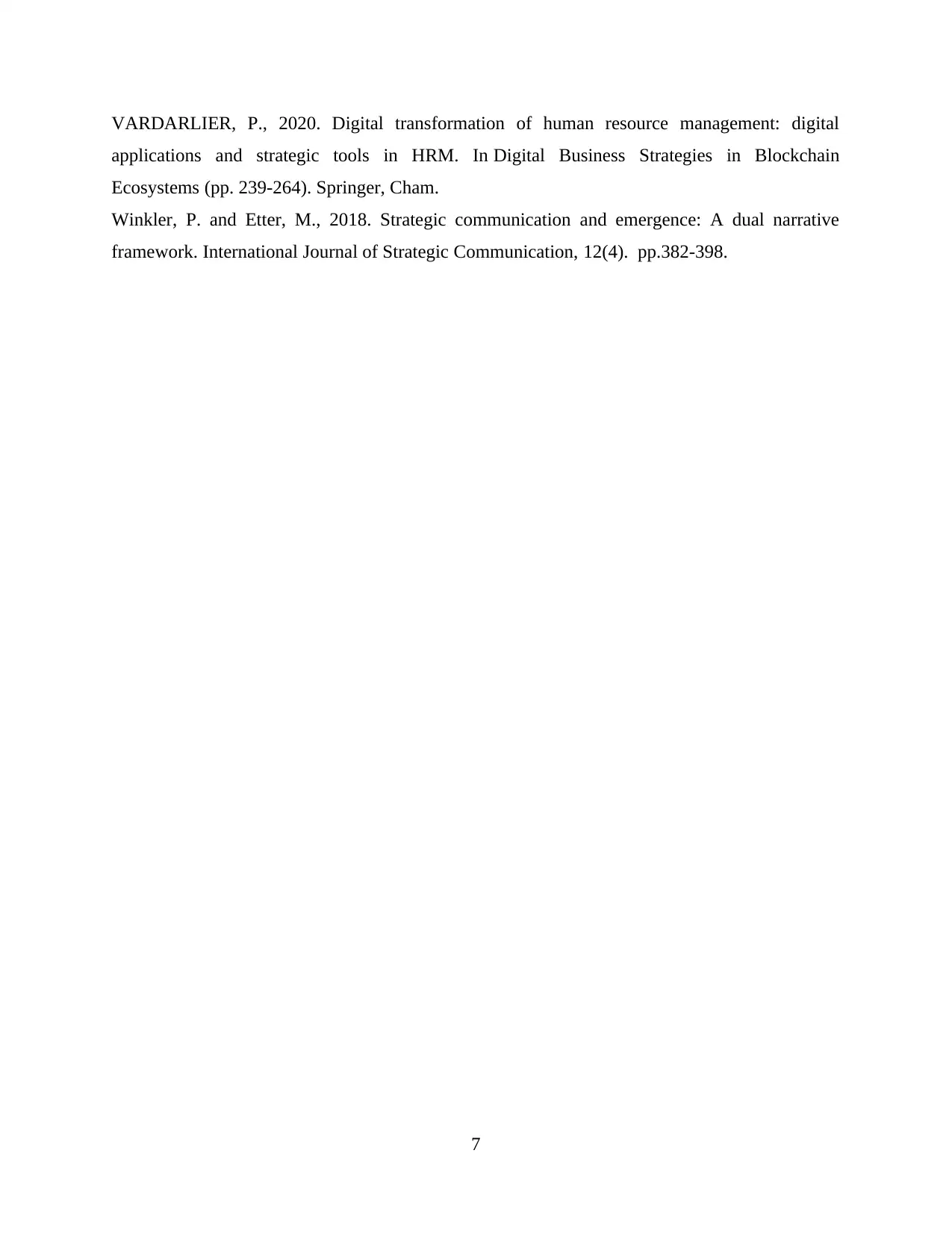
VARDARLIER, P., 2020. Digital transformation of human resource management: digital
applications and strategic tools in HRM. In Digital Business Strategies in Blockchain
Ecosystems (pp. 239-264). Springer, Cham.
Winkler, P. and Etter, M., 2018. Strategic communication and emergence: A dual narrative
framework. International Journal of Strategic Communication, 12(4). pp.382-398.
7
applications and strategic tools in HRM. In Digital Business Strategies in Blockchain
Ecosystems (pp. 239-264). Springer, Cham.
Winkler, P. and Etter, M., 2018. Strategic communication and emergence: A dual narrative
framework. International Journal of Strategic Communication, 12(4). pp.382-398.
7
⊘ This is a preview!⊘
Do you want full access?
Subscribe today to unlock all pages.

Trusted by 1+ million students worldwide

8
1 out of 10
Related Documents
Your All-in-One AI-Powered Toolkit for Academic Success.
+13062052269
info@desklib.com
Available 24*7 on WhatsApp / Email
![[object Object]](/_next/static/media/star-bottom.7253800d.svg)
Unlock your academic potential
Copyright © 2020–2025 A2Z Services. All Rights Reserved. Developed and managed by ZUCOL.



